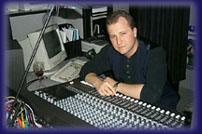 |
Steve Kornicki |
Morning Star Rising
| Instrumentation | Piccolo, 2 Flutes, 2 Oboes, 2 Clarinets in Bb, Bass Clarinet, 2 Bassoons, 4 Horns in F, 2 Trumpets in Bb, 2 Tenor Trombones, Bass Trombone, Tuba, Timpani*, Percussion (4)**, Harp, Strings
**Percussion 1: Glockenspiel, Vibraphone, Crotales
Percussion 2: Tubular Bells, Marimba
Percussion 3: Crash Cymbals, Tenor Drum, Small Tam-Tam
Percussion 4: Bass Drum, Triangle, Large Tam-Tam, Suspended Tambourine, Suspended Cymbal, Thunder Sheet
Score in C
Piccolo sounds one octave higher than notated
Basses sound one octave lower than notated |
| Length | 16 minutes |
| Difficulty | medium |
| Comments | Morning Star Rising was inspired by the book, Conversing with the Planets by astronomer and anthropologist, Anthony Aveni. The book's subject is ancient people's "celestial mythology" and how their rituals, beliefs and practices shaped their understanding of the natural world. Considerable focus is on the Maya and the importance they placed on the worship and deification of the planet Venus, portrayed as the morning and evening star gods.
"Heaven was not so far away in the eyes of these people (the Maya), who believed that individual, civic and social truths could be revealed by consulting with nature: the shifting of the wind, the arrival of the rain, the appearance of the stars" - Anthony Aveni
In contrast to the abstract tendencies of 20th century music, I have felt the need to return to programmatic sources and create concert music that relates to a historical context and at the same time is accessible and impressionistic. It is my intent in composing this work to return to the concept of the symphonic poem as practiced by composers such as R. Strauss and Sibelius. Musically, Morning Star Rising draws its inspiration from the gradually evolving tonality and structural architecture of Steve Reich's minimalist/pulse style along with the narrative mysticism and directly communicative orchestral textures of Gustav Holst's symphonic works . Reich and Holst represent for me a musical purity that was the motivation and direct musical influence for the overall contour of the work. The composition represents an imaginary depiction of an early morning ritual as practiced by the ancient Maya. The scenario for the 6 sections of Morning Star Rising is as follows:
1. Lamentation - the peoples' suffering and their need to implore the intervention of the gods
Winds and strings ebb and flow in freely sustained melodic patterns surrounded by varying lengths of silence portraying the cosmic views and deep-rooted connection to nature by the people. Later, harp and glockenspiel intone a steady pulse leading to the beginning of the dreamlike ritual. The tonality centers on an independent usage of the pitches of g minor, with occasional references to triadic configurations.
2. Procession and Prayer to the Sacred Star - in the pre-dawn darkness, the ceremony begins and the people proceed to their place of worship
Melodic percussion and pizzicato strings maintain the pulse while evolving thematic phrases are shared by groups within the orchestra invoking the "prayer". The harmony now alternates between c dorian and f mixolydian in 8 beat groups at a moderately paced tempo.
3. Sacrifice - the priests perform their powerful ritual of offering and sacrifice to the gods
Full orchestra is utilized for a climactic exaltation, thematically constructed from structural variations of the previous movements.
4. Appearance of the Star - it is early morning and solemnity falls upon the people after the priests have finished performing their homage; the star makes its appearance to all
Sustained strings give a distant impression of the dawn sky while winds, percussion and harp perform overlapping ostinato figures that represent the surrounding landscape and quiet contemplation of the congregation. An atmospheric texture is established with continuing free usage of the harmonic modes utilized thus far.
5. Morning Dance - a group of ecstatic women begin a primal and orgiastic dance that soon leads to a throng of jubilant celebration and rapture that is abruptly ended by the threatening decree of the priests
A driving, percussive section that reaches a climax of savage, accented orchestral chords along with pounding timpani. The music now in a tonality of 3 flats, returns to the alternating 2-part modal progression of the Procession movement with greater emphasis placed on rhythmic syncopation.
6. Adoration of the Earth - a representation of the ancients' awe of the power of the universe with the Earth acting as a witness to the continual cycle of humanity's reverence to her creations
A flute solo leads to slow pulsing harp chord-clusters. Sustained tones in an expansive Eb minor mode rise and fall against pizzicato strings creating an ethereal mosaic of sound eventually giving way to a final dissipating chord in woodwinds and horns. |
| Sources | Please visit the link below for audio MIDI realization (downloadable MP3) and score (PDF or Finale): http://www.howfarwouldyougo.com/forMusic/MorningStar/default.html |
| Extras | |
| History | (none) |
| Contributor | Steve Kornicki, kornicki@yahoo.com - composer
BMI, American Music Center
http://www.stevekornicki.com |
| Other | |
[ Catalog Home ]
[ Alphabetical ]
[ Contributors ]
[ Difficulty ]
[ Forces ]
[ Submissions ]
[ Submission Guidelines ]
|